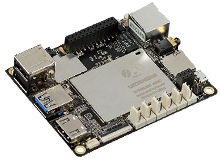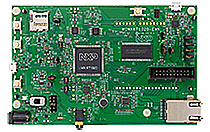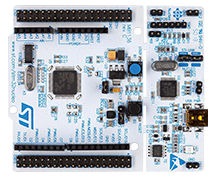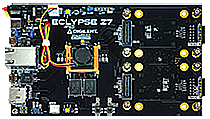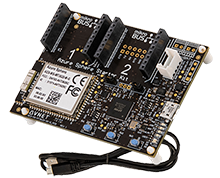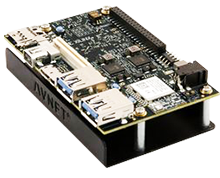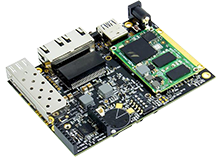Embedded Software I: Embedded OS
The element14 ESSENTIALS of Embedded Operating Systems covers embedded OSs, including their purpose, function, and basic concepts, as well as a discussion on Embedded Linux, Android, Windows CE, and RTOS. To extend the knowledge covered in the main module, this supplementary guide discusses some of the embedded single board computers and development boards currently available today.
Single Board Computer (SBC)
Raspberry Pi 4 Model B is the latest product in the popular Raspberry Pi range of computers. It offers ground-breaking increases in processor speed, multimedia performance, memory, and connectivity compared to the prior-generation Raspberry Pi 3 Model B+, while retaining backwards compatibility and similar power consumption. For the end user, Raspberry Pi 4 Model B provides desktop performance comparable to entry-level x86 PC systems. This product's key features include a high-performance 64-bit quad-core processor, dual-display support at resolutions up to 4K via a pair of micro-HDMI ports, hardware video decode at up to 4Kp60, 2GB of RAM, dual-band 2.4/5.0GHz wireless LAN, Bluetooth 5.0, Gigabit Ethernet, USB 3.0, and PoE capability (via a separate PoE HAT add-on). The dual-band wireless LAN and Bluetooth have modular compliance certification, allowing the board to be designed into end products with significantly reduced compliance testing, improving both cost and time to market.
The BeagleBone Black Wireless is an open source computer with built-in wireless networking capability. Leveraging a partnership with Octavo Systems and designed in EAGLE software, BeagleBone
Black Wireless is the easiest to use and modify credit-card sized IoT Linux computer available. The BeagleBoard Compatible Octavo OSD3358 system-in-package (SiP). The SiP has a Texas Instruments TPS65217C PMIC, Sitara AM335x MPU and TL5209 LDO.
|
|
The LattePanda is a complete Windows 10 single board computer. It comes pre-installed with a full edition of Windows 10 Home Edition, so you can run powerful tools such as Visual Studio, NodeJS, Java, Processing, and more. With existing APIs, you can develop your own software and hardware projects on a LattePanda like you would on a normal PC - C#, Javascript, Ruby etc. It also includes an integrated Arduino compatible co-processor, which means it can be used to control and sense the physical world.
Development Board
The Yún rev. 2 is a Linux based system that enables advanced network connections and applications. The Yún rev. 2 uses the Bridge library and so extends the board capabilities by using the Linux processor. The Arduino Yún rev. 2 is an Arduino board unlike any other. While programming it is very similar to the Arduino Leonardo and uses the same processor, the Atmel ATmega32U4, it also has an additional processor, an Atheros AR9331, running Linux and the OpenWrt wireless stack. Programming the 32U4 via USB is identical to the Arduino Leonardo. Once you've configured the Yún rev. 2 to connect to your WiFi network, you can program the 32U4 via WiFi as well.
 Based on ATmega32U4 AVR microcontroller and Atheros AR9331 Linux microprocessor
Based on ATmega32U4 AVR microcontroller and Atheros AR9331 Linux microprocessor
MIMXRT1020-EVK - Evaluation Kit, I.MX RT1020 Crossover Processor, Amazon FreeRTOS Support
Buy NowBuy Now
The i.MX RT1020 evaluation kit is a 2-layer through-hole USB-powered PCB. At its heart lies the i.MX RT1020 crossover processor in LQFP144 package, featuring NXP's advanced implementation of the Arm Cortex
-M7 core. This core operates at speeds up to 500MHz to provide high CPU performance and best real-time response. Support for Amazon FreeRTOS
available within the MCUXpresso SDK.
NUCLEO-L152RENUCLEO-L152RE - Development Board, STM32L152RET6STM32L152RET6 MCU, mbed-enabled
Buy NowBuy Now
The NUCLEO-L152RENUCLEO-L152RE is a STM32 Nucleo development board with an STM32L152RET6STM32L152RET6 MCU that allows users to build their own prototypes for embedded applications. The Arduino connectivity support and ST Morpho headers make it easy to expand the functionality of the STM32 Nucleo open development platform with a wide choice of specialized shields. The STM32 Nucleo board does not require any separate probe as it integrates the ST-LINK/V2-1 debugger/programmer. The STM32 Nucleo board series are based on ARM Cortex-M 32-bit RISC cores optimised for high performance and energy efficiency. ARM Cortex-M features a high density instruction set and a Nested Vectored Interrupt Controller (NVIC) providing excellent interrupt handling abilities.
|
|
The Eclypse Z7 is an FPGA/SoC development board, specifically designed to enable the rapid prototyping and development of embedded measurement systems. Featuring high-speed Zmod ports for modular expansion, a Xilinx Zynq-7020 SoC plus software API from Digilent, the Eclypse Z7 is fast, flexible and shortens the time it takes for engineers and researchers to develop innovative and powerful new high-speed instrumentation, control, and measurement systems for edge-computing, medical, and communications applications. Eclypse Z7 is the first host board of the Eclypse Platform.
The Avnet Azure Sphere MT3620 Starter Kit supports rapid prototyping of highly secure, end-to-end IoT implementations using Microsoft's Azure Sphere. The small form-factor carrier board includes a production-ready MT3620 Sphere module with Wi-Fi connectivity, along with multiple expansion interfaces for easy integration of off-the-shelf sensors, displays, motors, relays, and more. The downloadable getting started tutorial guides developers through the development steps from board setup to application coding.
The Ultra96-V2 is an Arm-based, Xilinx Zynq UltraScale+ MPSoC development board based on the Linaro 96Boards Consumer Edition (CE) specification. Ultra96-V2 will be available in more countries around the world as it has been designed with a certified radio module. Additionally, all components are updated to allow industrial temperature grade options. Additional power control and monitoring will be possible with the included Infineon Pmics. The Ultra96-V2 boots from the provided Delkin 16 GB microSD card. Engineers have options of connecting to Ultra96-V2 through a Webserver using integrated wireless access point capability or to use the provided PetaLinux desktop environment which can be viewed on the integrated Mini DisplayPort video output. Multiple application examples and on-board development options are provided as examples. Ultra96-V2 provides four user-controllable LEDs. Engineers may also interact with the board through the 96Boards-compatible low-speed and high-speed expansion connectors by adding peripheral accessories.
Harnessing the robust processing abilities of the ARMADA 388 SoC from Marvell, the ClearFog offers application potential as a flexible development board or a ready to deploy solution. Alongside the powerful ARMADA 388 SoC, the ClearFog includes a variety of I/O and connectivity technologies such as multiple mPCIe/mSATA sockets, PoE expansion header, audio/telephony module header, mikroBUS - a simple socket allowing you to integrate a wide range of MikroElektronika click boards
modular extensions, making ClearFog the perfect edge or fog computing solution. ClearFog Base SBC is equipped with numerous I/O options, and is compatible with a variety of power, memory and storage configurations. Device makers can easily bridge a variety of different network standards like LAN, Wi-Fi, Cellular, Fiber and DSL, as well as utilize mikroBUS boards for IoT type networking standards such as ZigBee, Sub GHz, Bluetooth and others.
|
*Trademark. element14 is a trademark of AVNET. Other logos, product and/or company names may be trademarks of their respective owners.




